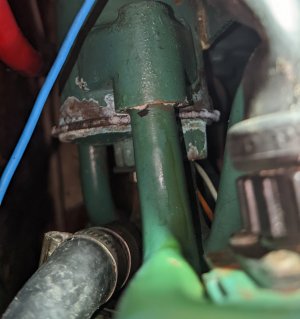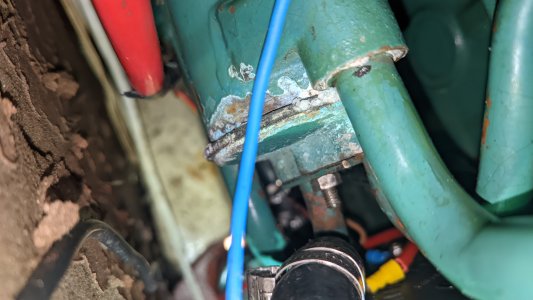eladn
New member
Hi all,
We have a VP2003 mounted on our Carter 33 and some erratic engine temperature has been observed recently. It is a dual fresh-saltwater cooled engine with a heat exchanger mounted above the alternator. I shall first lay out the observations then list what was done with regards to the cooling system:
Questions:
Elad (mnemonic: "a lad")
We have a VP2003 mounted on our Carter 33 and some erratic engine temperature has been observed recently. It is a dual fresh-saltwater cooled engine with a heat exchanger mounted above the alternator. I shall first lay out the observations then list what was done with regards to the cooling system:
- Under no load the engine does not heat above the normal working temperature - the needle fluctuates between around 78-80c as the thermostat does its work
- The other day I was motoring for several hours at a decent 2000 RPMs, no problem
- The day after, motored for 2 hours. During the end of the run, after about 1h45m the engine temperature needle went up erratically to about 90-95 momentarily, then back down to about 80-85. RPMs were lowered to about 1100 to allow latent heat to discharge, after which temperature was under control around 85c
- The day after, doing some checks on piping, making sure enough saltwater goes in and out of the system, did a load test while motoring out of the bay, for about 20m, out of which 10-15m were at 2500 RPMs, temperature was holding on about 80c
- The day after, while motoring on idle+ under very little load, temperature was at 90c and holding, later on that day while motoring into the bay no problems were observed (on low RPMs)
- A visual inspection on the motor yesterday showed that the forward part of the HE has suffered some high temperatures, with some slight deposits around the point where the faceplate meets the cylinder (looks like salt but I haven't tasted it), and the large gasket seems a bit bloated than before (see attachment)
- After reading this very useful thread, did a test (no load, about 2000 RPMs) to get the engine to working temp so that the tstat opens (took about 10m). HE then warms up but only at the front part (about half of it at the front is warm). If I touch the HE at the back (where the spigot is), it is still at ambient temp. I was allowing the motor to keep on running for another 5m with no change on this, still back of HE is "cold".
- Freshwater pump (circulation) was removed and completely renovated a few weeks ago
- Impeller checked a few weeks ago (and as checked, saltwater flow looks good throughout)
- Saltwater strainer checked and cleaned (not much was in there)
- Front HE gasket replaced by our engineer a few weeks ago (not an original gasket; cutout from a different material)
- Exhaust elbow taken off and cleaned (about 2 years ago)
- Thermostat replaced a few weeks ago
- We have not used any cooling system flushing compound (i.e. decalc). The motor was bought only a couple of years back, and the boat has been in the water since (with motor regularly started over the winter periods. i.e. no coolant in the SW circuit on layup)
Questions:
- Would it be possible to clean the HE just by opening the faceplate cover at the aft section? Having taken the HE off before I am not so much looking forward to putting it on again (push-fittings and all). I have nevertheless ordered all necessary gaskets and o-rings to do so. Would it be possible to clean it just by boring the small shafts or is there a risk of damaging them such that the freshwater might be mixing with the saltwater then?
- In case that the HE needs to be taken off for cleaning, my understanding that needs to be done with acid, however which and at which concentration?
- I would expect a uniform temperature diffusion across the whole body of the HE once the tstat opens, is this a correct assumption?
- Would it be ok to flush the freshwater circuit with pressure? Is there a risk of damaging anything?
- Would it make sense to try to go into the block FW circuit with some wire and try to poke at it? Some people mentioned poking in there with a hanger-wire, is there a risk of damaging anything?
- Some forums mention de-calcifying the cooling system (salt or freshwater?). Does this need to be done on-top of cleaning the HE? is the freshwater system even at risk from any sediment/deposit?
Elad (mnemonic: "a lad")


